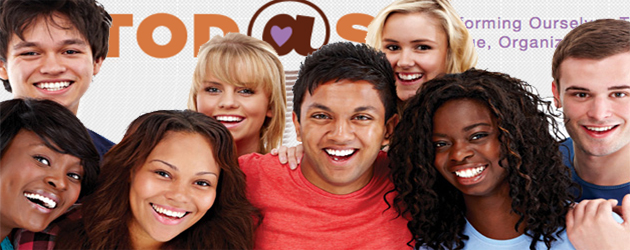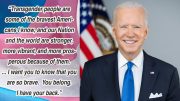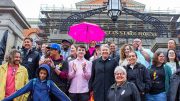 By: Nicole Lashomb/Editor-in-Chief—
By: Nicole Lashomb/Editor-in-Chief—
BOSTON, Mass.—Alarming figures indicate that up to 75 percent of LGBTQ individuals have experienced Intimate Partner Violence (IPV), as found in a recent medical review. Local agencies have joined forces and are tackling the epidemic by breaking through the barriers surrounding the abuse, often rooted in cultural bias and shaming practices.
“When we look at different tactics of abuse, or different ways that people can be abusive, we often note categories such as physical, sexual, and verbal/emotional,” said Amy Santana, Youth Counselor & Outreach Worker, Violence Recovery Program at Fenway Health. “Working with same-sex couples means also looking at cultural abuse. This can include tactics related to a person’s race/ethnicity, but also extends into specific tactics that are unique to the LGBQ/T community, such as outing, withholding hormones, or using the wrong pronouns for someone. Therefore, the number of tactics available to an abuser in a same-sex relationship has increased.”
A Northwestern Medical review discovered that 25 percent to 75 percent of LGBTQ individuals have been affected by IPV. However, it also noted there was a lack of data due to underreporting of abuse likely caused by the stress and stigma revolving around being an LGBT individual. It suggested the rate of IPV is also higher.
“Individuals within the LGBQ/T community can have a much more difficult time accessing services, and can even experience discrimination from providers,” explained Santana. “Because our society portrays abuse as being between a man and a woman, with the man being the abuser, it can be difficult for providers to even recognize abuse in same-sex relationships. They may feel that the abuse is mutual or may defer to whoever is more masculine as automatically being the abuser. It can be difficult even to know which agencies have providers who are not homophobic or transphobic.”
The medical review’s key findings noted that People of Color made up the majority of total survivors. [pullquote]“LGBQ/T people face many barriers in community—from lack of acceptance around their sexual orientation and/or gender identity to barriers to accessing services.”—Vilma Uribe, Community Organizer at The Network/La Red[/pullquote]
Vilma Uribe, Community Organizer at The Network/La Red, said identifying as LGBTQ carries a stigma that is often used by society and the abuser to shame the survivor.
“LGBQ/T people face many barriers in community—from lack of acceptance around their sexual orientation and/or gender identity to barriers to accessing services,” she said. “That, compounded with the experience of violence in their relationship, can amplify the violence that survivors experience.”
TOD@S Collaborative was launched to serve the unique needs of the LGBTQ People of Color. The coalition includes the Violence Recovery Program at Fenway Health, Hispanic Black Gay Coalition, The Network/La Red and Renewal House.
According to a recent press release from the Collaborative, “factors like racism and other forms of oppression and discrimination, as well as cultural stigmas or taboos, often make it even more difficult for LGBQ/T people of color survivors to talk about sexuality or gender identity, much less domestic violence/partner abuse,” it read.
Oppression compounds the challenges faced by survivors, especially by survivors of color.
“When you view domestic violence through the lens of oppression, being someone who is experiencing multiple layers of oppression associated with their different identities absolutely plays a part,” Santana said. “These multiple identities become ways that an abuser can further victimize their partner. The abuser can use the tactic of outing the person to their faith community or to their family. It is often the case that LGBQ/T individuals who are also part of communities of color, feel that they are not able to have all their identities exist at once in every space they must navigate. Therefore, threatening to out a very masculine Latino male, for example, may mean that he will be rejected by his community.”
Uribe, the daughter of Mexican immigrants, also said that language barriers can increase the fear of reaching out for help, thereby limiting access to services for non-native English speakers.
Enter the police.
A history of police brutality experienced by People of Color adds to a reluctance of reaching out for help, pointed out Francesca Contreras, Residential & Community Advocate for Renewal House and coordinator of the TOD@S Collaborative.
According to the National Coalition of Anti-Violence Program’s 2013 report on IPV, “LGBQ/T people of color are more likely to suffer injuries, require medical attention or face anti-LGBTQ bias as a result of partner abuse, and are often reluctant to contact law enforcement due to the history of police violence against communities of color,” the report read. [pullquote]According to the National Coalition of Anti-Violence Program’s 2013 report on IPV, “LGBQ/T people of color are more likely to suffer injuries, require medical attention or face anti-LGBTQ bias as a result of partner abuse, and are often reluctant to contact law enforcement due to the history of police violence against communities of color,” the report read. [/pullquote]
Not only is there bias within law enforcement affecting assistance for LGBT people of color, but providers are also not as educated about issues impacting these marginalized communities.
“From my own personal experience advocating for survivors, I find that domestic violence providers are not as familiar with issues that affect LGBQ/T people of color,” Uribe said. “In particular, when advocating for shelter for transgender and gender non-conforming people and men, often times, I hear hesitancy to accept [them] because staff at other programs don’t feel that they have the adequate training to work with transgender people and men.”
Finding a shelter is especially difficult if someone is transgender due to many shelters not being open to the transgender community, Santana explained.
“Our communities are often invisible or overlooked in public conversations about domestic violence and sexual assault, and it is all of our responsibility to change that reality,” Contreras added. “From shelter services to police responses and the legal system, institutions need to be held accountable to [serve the needs of] queer and trans people of color.”
Through TOD@S, Santana is focused on facilitating changes for survivors, specifically for disenfranchised LGBQ/T communities affected by abuse. [pullquote]TOD@S Collaborative was launched to serve the unique needs of the LGBTQ People of Color. The coalition includes the Violence Recovery Program at Fenway Health, Hispanic Black Gay Coalition, The Network/La Red and Renewal House.[/pullquote]
“My hope for our TOD@S project is that we bring more awareness to, not only the fact that domestic violence does happen in LGBQ/T communities, but also to queer and transgender communities of color,” she said. “Depictions of LGBQ/T people in the media in general are few, but even fewer are those depicting LGBQ/T people of color. We wanted to show examples celebrating relationships within this very specific community that is often overlooked. So, I suppose my hope is both that queer and trans people of color experiencing domestic violence/partner abuse can now know that there’s help tailored to their specific needs, as well as giving more visibility to the beautiful, healthy relationships within the QTPOC* community as well.”
If you are a survivor in an abusive relationship and need assistance, contact TOD@S Collaborative by visiting www.todosinaction.org or reach out to one of the providers below.
Contact Fenway Health’s Violence Recovery Program at 617-927-6250 or visit http://goo.gl/MmxJj4.
To reach The Network/La Red visit www.tnlr.org, call 617-742-4911 (voice), or 617-227-4911 (tty).
For more information on the Renewal house, visit www.renewalhouse.org or call (615) 255-5222.
Contact the Hispanic Black Gay Coalition (HBGC) at www.hbgc-boston.org or call 617-487-4242.
*Queer and Trans People of Color







